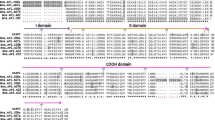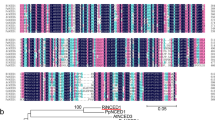Abstract
EPSPS is coded with the aroA gene, a key enzyme that catalyzes the penultimate step of shikimate pathway. The current study focuses on the suppression of aroA gene in weedy Brassica rapa. For this purpose B. rapa was transformed with double-stranded RNA interference construct designed to silence aroA gene. This developed in a significant decline in EPSPS (about 72 %) in T0 and T1 plants. In order to study the gene flow, the B. rapa control and B. napus plants were pollinated with T0 B. rapa. Results showed that in the next generation of challenging plants, the pollinated normal B. rapa showed the T1 symptoms and performance. Statistical analysis of data showed that knocking down of aroA will lead to a weakness and decreasing in investigated morphological, physiological and phonological characteristics. Meanwhile pollinated B. napus plant species have been not fertilized by T0 B. rapa. To conclude current result is the first evidence of aroA gene inhibition induces a high decrease in EPSPS protein in B. rapa. Also this result provides a basis for the future investigation in order to controlling B. rapa via molecular approach along with agronomical, biological and chemical methods regarding environmental considerations.





Similar content being viewed by others
References
Holm L, Doll J, Holm E, Pancho J, Herberger J (1997) World Weeds. Natural Histories and Distribution. John Wiley and Sons Inc, USA
Lu CM, Kato M, Kakihara F (2002) Destiny of a transgene escape from Brassica napus into Brassica rapa. Theor Appl Genet 105:78–84
Kahrizi D, Salmanian AH, Afshari A, Moieni A, Mousavi A (2007) Simultaneous substitution of Gly96 to Ala183 to Thr in 5-enolpyruvylshikimate 3-phosphate synthase gene of E. coli (k12) and transformation of rapeseed (Brassica napus L.) in order to make tolerance to glyphosate. Plant Cell Rep 26:95–104
Kahrizi D, Salmanian AH (2008) Substitution of Ala183Thr in aroA Product of E. coli (k12) and Transformation of Rapeseed (Brassica napus) with Altered Gene to Tolerance of Plant to Roundup. Transgenic Plant J 2(2):170–175
Cheévre AM, Eber F, Baranger A, Hureau G, Barret P, Renard M (1998) Characterization of backcross generations obtained under field conditions from oilseed rape-wild radish F1 interspecific hybrids: an assessment of transgene dispersal. Theor Appl Genet 97:90–98
Jørgensen RB, Andersen B (1994) Spontaneous hybridization between oilseed rape (Brassica napus) and weedy B. campestris (Brassicaceae): a risk of growing genetically modified oilseed rape. Am J Bot 81:1620–1626
Chevre AM, Eber F, Baranger A, Renard M (1997) Gene flow from transgenic crops. Nature 389:924
Hansen LB, Siegismund HR, Jørgensen RB (2003) Progressive introgression between Brassica napus (oilseed rape) and B. rapa. Heredity 91:276–283
Warwick SI, Légère AL, Simard MJ, James T (2008) Do escaped transgenes persist in nature? The case of an herbicide resistance transgene in a weedy Brassica rapa population. Mol Ecol 17:1387–1395
Himanen SJ, Nerg AM, Poppy GM, Stewart CNJ, Holopainen JK (2010) Abiotic stress and transgenics: implications for reproductive success and crop-to-wild gene flow in Brassicas. Basic Appl Ecol 11:513–521
Scott SE, Wilkinson MJ (1998) Transgene risk is low. Nature 393:320
Kuiper HA, Kleter GA, Noordam MY (2000) Risks of the release of transgenic herbicide-resistant plants with respect to humans, animals, and the environment. Crop Prot 19:773–778
Cogoni C, Macino G (2000) Post-transcriptional gene silencing across kingdoms. Curr Opin Genet Dev 10:638–643
Khraiwesh B, Arif MA, Seumel GI, Ossowski S, Weigel D, Reski R, Frank W (2010) Transcriptional control of gene expression by microRNAs. Cell 140:111–122
Smith HA, Swaney SL, Parks TD, Wernsman EA, Dougherty WG (1994) Transgenic plant virus resistance mediated by untranslatable sense RNAs: expression, regulation, and fate of nonessential RNAs. Plant Cell 6:1441–1453
Wiedemann G, Hermsen C, Melzer M, Büttner-Mainik A, Rennenberg H, Reski R, Kopriva S (2010) Targeted knock-out of a gene encoding sulfite reductase in the moss Physcomitrella patens affects gametophytic and sporophytic development. FEBS Lett 584:2271–2278
Khraiwesh B, Ossowski S, Weigel D, Reski R, Frank W (2008) Specific gene silencing by artificial microRNAs in Physcomitrella patens: an alternative to targeted gene knockouts. Plant Physiol 148:684–693
Chunli S, Junlian M, Xia T, Zide Z, Zhixia H (2009) Strawberry FaEtr2 gene RNAi expression vector construction and genetic transformation. Front Agric China 3(4):419–424
Niu JH, Jian H, Xu JM, Guo YD, Liu Q (2010) RNAi technology extends its reach: engineering plant resistance against harmful eukaryotes. Afr J Biotechnol 9(45):7573–7582
Sambrook J, Russell DW (2001) Molecular cloning, a laboratory manual. Cold Spring Harbor Laboratory Press, New York
Wesley SV, Helliwell CA, Smith NA (2001) Construct design for efficient, effective and high throughput gene silencing in plants. Plant J 27:581–590
Gleave AP (1992) A versatile binary vector system with a T-DNA organisational structure conducive to efficient integration of cloned DNA into the plant genome. Plant Mol Biol 20:1203–1207
Murray MG, Thampson WF (1980) Rapid isolation of high molecular weight plant DNA. Nucleic Acids Res 8:4321–4325
Abbott JC, Barakate A, Pincon G, Legrand M, Lapierre C, Mila I, Schuch W, Halpin C (2002) Simultaneous suppression of multiple genes by single transgenes. Down-regulation of three unrelated lignin biosynthetic genes in tobacco. Plant Physiol 128:844–853
Wang HY, Li YF, Xie LX, Xu P (2003) Expression of bacterial aroA mutant, aroA-M1, encoding 5-enolpyruvylshikimste-3phosphate synthase for the production of glyphosate-resistant tobacco plants. J Plant Res 116:455–460
Husken A, Baumert A, Strack D, Becker HC, Möllers C, Milkowski C (2005) Reduction of sinapate ester content in transgenic oilseed rape (Brassica napus) by dsRNAi-based suppression of BnSGT1 gene expression. Mol Breed 16:127–138
Bucher E, Lohuis D, van Poppel PM, Geerts-Dimitriadou C, Goldbach R, Prins M (2006) Multiple virus resistance at a high frequency using a single transgene construct. J Gen Virol 87:3697–3701
Bing DJ, Downey RK, Rakow FW (1996) Hybridizations among Brassica napus, B. rapa and B. juncea and their two weedy relatives B. nigra and Sinapis arvensis under open pollination conditions in the field. Plant Breed 115:470–473
Brown J, Brown AP (1996) Gene transfer between canola (Brassica napus L. and B. campestris L.) and related weed species. Ann Appl Biol 129:513–522
Butruille DV, Guries RP, Osborn TC (1999) Increasing yield of spring oilseed rape hybrids through introgression of winter germplasm. Crop Sci 39:1491–1496
Budewig S, Léon J (2003) Higher yield stability for oilseed rape hybrids. In: 11th International Rapeseed Congress, Copenhagen, Denmark, 6–10 July 2003, pp 347–349
Han-Zhong W, Gui-Hua L, Xin-Fa W, Jing L, Qing YM, Wei H 2009 Heterosis and breeding of high oil content in rapeseed (Brassica napus L.). In: 16th Australian Research Assembly on Brassicas, Ballarat, Victoria
Lu C, Kato M, Kakihara F (2002) Destiny of a transgene escape from Brassica napus into Brassica rapa. Theor Appl Genet 105:78–84
Acknowledgments
Razi University has financially supported this research Project No. 996. I thank Dr. Noorbakhsh Hooti for critical reading of this manuscript and Dr. K. Yari (Medical Biology Research Center, Kermanshah University of Medical Sciences, Kermanshah, Iran) for technical supports. Thanks to Zagros Biotechnology Section of Razi University Incubator for technical Supports.
Author information
Authors and Affiliations
Corresponding author
Rights and permissions
About this article
Cite this article
Kahrizi, D. Reduction of EPSP synthase in transgenic wild turnip (Brassica rapa) weed via suppression of aroA. Mol Biol Rep 41, 8177–8184 (2014). https://doi.org/10.1007/s11033-014-3718-0
Received:
Accepted:
Published:
Issue Date:
DOI: https://doi.org/10.1007/s11033-014-3718-0




